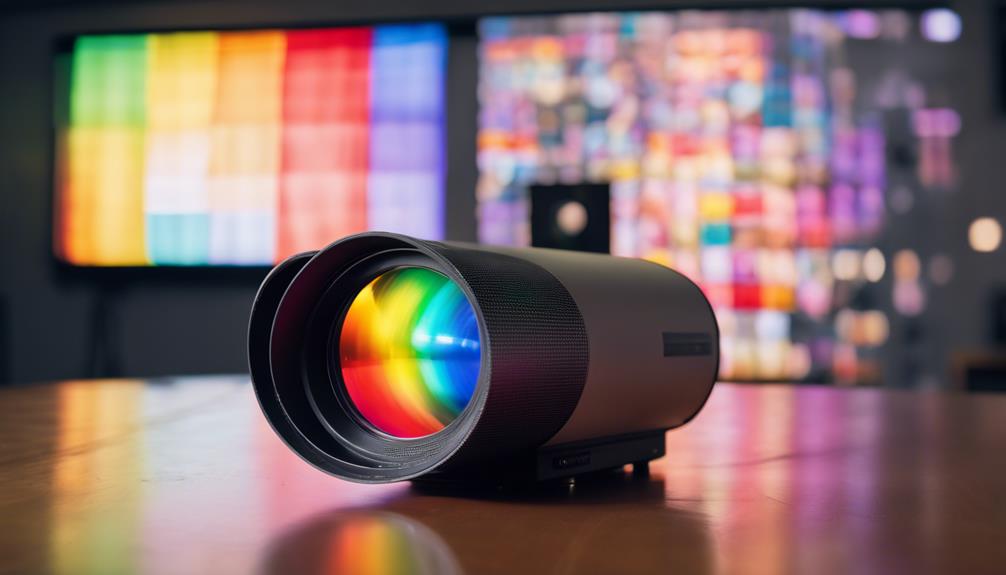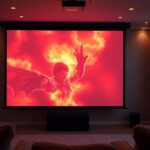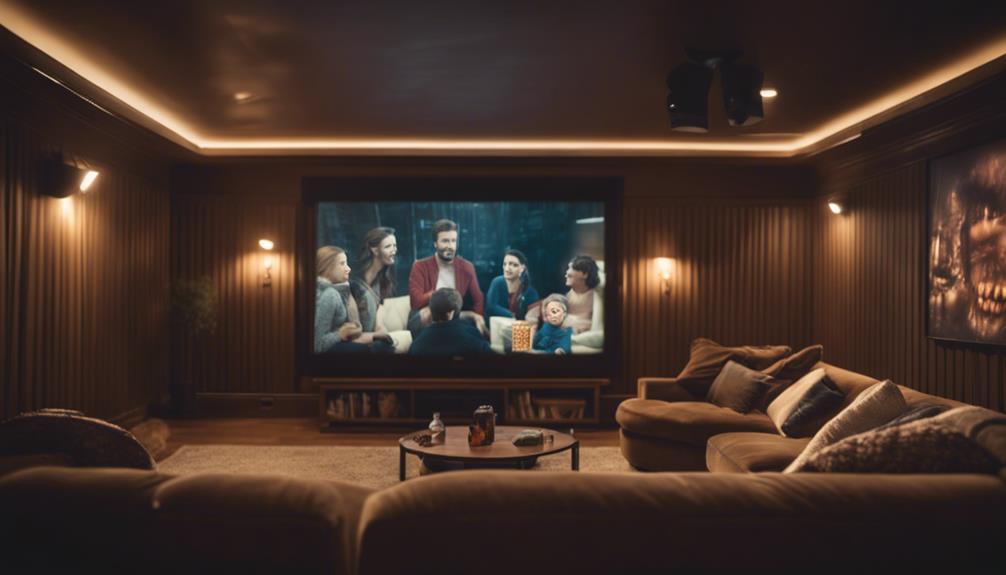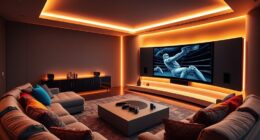Screen gain plays a vital role in your projector's performance, directly impacting brightness and color accuracy. High gain screens enhance brightness markedly, making them perfect for bright environments, but they can limit viewing angles and affect color fidelity. On the other hand, low gain screens provide wider angles and better color precision, ideal for darker rooms. The right choice depends on your room's lighting and projector specifications. By matching the screen gain to your setup, you can maximize image quality. There's much more to uncover about how screen gain can enhance your viewing experience.
Key Takeaways
- Screen gain affects brightness and color accuracy, influencing the overall viewing experience of projected images.
- High gain screens enhance brightness in bright environments but may compromise viewing angles and color reproduction.
- Low gain screens provide wider viewing angles and better color fidelity, ideal for controlled lighting scenarios.
- The choice of screen gain should consider room lighting and projector output for optimal performance.
Understanding Screen Gain

Screen gain is an essential factor that measures how effectively a projector screen reflects light, impacting the overall viewing experience. When you choose a screen, understanding gain helps you optimize brightness and color accuracy for your projected image.
High gain screens, with a gain greater than 1.0, boost brightness considerably, making them ideal for environments with ambient light. However, they often come with trade-offs, like narrower viewing angles and compromised color fidelity.
On the other hand, low gain screens, typically below 1.0, offer wider viewing angles and better color accuracy, making them suitable for dedicated home theaters with controlled lighting. These screens may not reflect as much light, but they guarantee that everyone in the room enjoys a consistent and vibrant image.
When considering screen gain, think about where you'll be using your projector. If you're in a well-lit room, a high gain screen might be your best bet for achieving that bright, clear projected image. Conversely, if you're aiming for an immersive experience in a darkened space, a low gain screen could provide the color accuracy and wider viewing angles you need.
Importance of Screen Selection

Choosing the right screen can greatly enhance your projector's performance, ensuring that every detail of your image is displayed with clarity and vibrancy.
Screen selection is essential because a compatible screen markedly boosts brightness and contrast, directly affecting your viewing experience. If you often deal with ambient light, a well-chosen screen can mitigate its effects, allowing you to enjoy clearer and more vibrant images.
The materials and formulations of screens play important roles in color accuracy and image uniformity. When you invest in a high-quality screen, you prevent the dilution of your projector's capabilities, maximizing the potential of your home theater or presentation setup.
Remember, a projector's performance can only shine through a screen that complements it well.
Balancing your budget between the projector and screen is critical. Compromising on screen quality can lead to a subpar viewing experience, even if you have a top-of-the-line projector.
Ultimately, the synergy between your projector and screen is key to achieving ideal brightness and clarity, enhancing your overall image quality. Make an informed choice with your screen selection to fully realize your projector's capabilities.
High Gain Vs Low Gain

When deciding between high gain and low gain options, understanding their impact on your viewing experience is essential.
High gain screens, rated above 1.0, are designed to enhance the brightness of the projected image, especially in environments with significant ambient light. They're perfect for presentations or situations where you can't control the lighting. However, this increased brightness can come at the cost of color accuracy and uniformity, leading to hotspotting where the center of the image is much brighter than the edges.
On the other hand, low gain screens, rated below 1.0, provide wider viewing angles and superior color accuracy, making them the go-to choice for dedicated home theaters. These screens work best in controlled lighting conditions and are ideal for lower lumen projectors (under 1,000 lumens), ensuring you don't sacrifice detail in darker scenes.
Ultimately, your choice should hinge on your specific projector brightness, the ambient light in your room, and how you plan to arrange seating. By carefully considering these factors, you can achieve the best possible viewing experience tailored to your specific needs.
Measuring Screen Gain

To accurately measure screen gain, you'll need a reliable light meter and a standard reference screen with a gain of 1.0.
The process involves projecting a test pattern and taking precise readings at the ideal viewing angles.
Required Measurement Tools
Accurately measuring screen gain typically requires a reliable light meter to quantify the brightness reflected from the screen surface.
You'll want to project a test pattern onto the screen to establish a consistent reference for measuring brightness levels. This step is essential for achieving precise gain measurement.
Ensure you carefully measure the distance between the projector and the screen, as this can markedly influence your gain calculation.
To determine peak brightness, measure gain at the Zero Degree Viewing Angle, where you'll achieve the highest level of brightness reflected.
Additionally, it's important to measure at the Half Gain Viewing Angle, where the brightness drops to 50% of its peak value.
Gain Calculation Process
Measuring screen gain involves comparing the brightness of a projected image on your screen to that of a reference surface with a gain of 1.0. To perform this gain calculation, you'll need a light meter. Position the meter at the center of the screen, ideally at a 0° viewing angle, where the screen typically appears brightest. This guarantees your measurements accurately reflect the screen's performance.
The formula for screen gain is simple:
Screen Gain = Brightness on Perfect Surface (1.0) / Brightness on the Screen.
This allows you to quantify the reflectivity of your screen.
Remember, higher gain screens often focus light into a narrower angle, which means off-angle viewers may not experience the same brightness. This leads to the concept of the Half Gain Viewing Angle, where the screen's brightness drops to 50% of its peak.
Understanding this angle is vital for evaluating how projector performance is affected by screen gain. By keeping these factors in mind, you can effectively evaluate your screen's performance and make informed decisions about your setup.
Environmental Considerations

When choosing a projector screen, you need to think about the room's lighting and size.
Bright environments might require high-gain screens to boost image brightness, while darker, controlled spaces can benefit from low-gain options for better contrast.
Additionally, the size of the room will impact how well your screen performs, especially if you're aiming for an immersive viewing experience.
Room Lighting Effects
Room lighting plays an essential role in determining the ideal projector screen gain, affecting how vibrant and clear your images will appear.
If you're in a bright environment with considerable ambient light, high-gain screens are your best bet. They enhance the perceived brightness of the projected image, providing up to 20% more reflectivity with a gain greater than 1.0. This is especially useful in spaces like conference rooms or living areas where controlling light is challenging. However, be cautious—high-gain screens can create hotspots and color shifts when viewed from off-center angles.
On the other hand, if your setup involves controlled lighting conditions, such as a dedicated home theater, low-gain screens can be advantageous. They improve the contrast ratio and enhance black levels, delivering a richer viewing experience in darker environments. In these settings, the limited ambient light allows for a more uniform image across the viewing cone, ensuring you get the most out of your projector.
Ultimately, understanding how room lighting interacts with screen gain can greatly elevate your viewing experience.
Screen Size Considerations
Choosing the right screen size directly impacts your projector's performance and image quality, so it's crucial to take into account both your space and projector specifications. Here are three key considerations:
- Projector Brightness: Larger screens require projectors with higher brightness to maintain image clarity. If you're using a low-lumen projector (under 1,000 lumens), a larger screen may lead to dim images, especially with low-gain screens.
- Ambient Light: Your room's ambient light affects how a screen performs. In bright environments, you may need to opt for a smaller screen or one with higher gain to counteract light interference and enhance image brightness.
- Seating Arrangements: Consider how your audience is seated. If you have a larger audience, a wider viewing angle might be necessary, which could mean using low-gain screens for uniform brightness across the space.
Projector and Screen Compatibility

How can you guarantee your projector and screen work seamlessly together to deliver the best image quality?
Start by considering the screen gain and how it interacts with your projector's specifications.
For instance, if you have a low-output projector, a high gain screen can considerably boost the brightness of the projected image, making it more visible in well-lit rooms.
However, if you're using a high-lumen projector, a low-gain screen might be the better choice to maintain color accuracy and image quality.
Advantages of High Gain Screens

High gain screens can really boost the brightness of your projected image, making it easier to see even in bright environments.
They work especially well in home theater setups where the overall configuration, including the essential components like projectors and audio systems, plays a significant role in the viewing experience.
If you're presenting to a fixed audience, these screens provide ideal visibility without needing to adjust your projector settings.
You'll appreciate the vibrant, focused images they create, especially when seated directly in front of the screen.
Enhanced Image Brightness
A high gain screen greatly boosts image brightness, making it ideal for environments with low projector output or ambient light. With values exceeding 1.0, these screens can reflect 20-50% more light than standard screens, resulting in a notably brighter image. For instance, using a 1.5 gain screen turns a 1,000 lumen projector into an equivalent of 1,500 lumens, enhancing visibility and clarity.
Here are three key advantages of high gain screens:
- Brighter Projected Images: They effectively increase the brightness of projected images, ensuring that viewers see vibrant visuals even in well-lit rooms.
- Best Visual Clarity: By focusing light into a narrower viewing angle, high gain screens deliver best visual clarity for those seated directly in front.
- Improved Performance in Ambient Light: These screens excel in combating ambient light hitting the surface, maintaining a vivid display that's essential for presentations.
However, keep in mind that while you gain brightness, you might sacrifice some color accuracy and viewing angles, which could affect larger audiences.
Ideal for Fixed Seating
For environments with fixed seating, high gain screens provide remarkable advantages by directing enhanced brightness precisely where it's needed most.
These screens considerably boost perceived brightness, making them perfect for settings with controlled lighting. When you use a high gain screen with a gain of 1.5, a projector outputting 1,000 lumens can seem as bright as 1,500 lumens, enhancing the viewing experience for your audience.
In scenarios like presentations or theaters, where viewers sit directly in front of the screen, high gain screens guarantee ideal visibility. They concentrate light within a narrow viewing cone, minimizing light loss and maintaining uniform brightness for everyone in fixed seats.
Additionally, many high gain screens are designed to reduce hotspotting, further enhancing the clarity and consistency of the image across the screen.
The narrow viewing angles of these screens make them particularly suitable for fixed seating arrangements, as they preserve brightness and image quality for those positioned within the ideal viewing zone.
Disadvantages of High Gain Screens

Many users discover that high gain screens come with significant drawbacks that can impact their viewing experience. While they may boost brightness, the downsides can make these screens less desirable for many setups. Here are three critical disadvantages to take into account:
- Reduced Viewing Angles: High gain screens often suffer from limited viewing angles. If you're not seated directly in front of the screen, you may notice a significant drop in brightness, making it hard to enjoy the image fully.
- Hotspotting: This phenomenon occurs when the center of the image is much brighter than the edges. Hotspotting can detract from overall image uniformity, leading to a less enjoyable viewing experience.
- Color Reproduction Issues: Accurate color fidelity can be a challenge with high gain screens. You might experience color shifts when viewing from different angles, making it difficult to appreciate the intended visuals, especially in a group setting.
Due to light directionality, these screens may require a smaller seating area for ideal viewing, limiting your audience and impacting overall screen performance.
Ideal Gain for Home Theater

Choosing the ideal screen gain for your home theater is crucial to achieving the best image quality and color accuracy.
In a controlled lighting environment, a low-gain screen (0.8-1.0) will enhance your image quality while maintaining vibrant colors. This is particularly important for dedicated home theater set-ups where ambient light can't interfere with your viewing experience.
If your space has some ambient light, consider a moderate-gain screen (1.0-1.3). This option strikes a balance between projector brightness and color fidelity, guaranteeing you still enjoy great visual performance.
In contrast, high-gain screens (1.3+) are suitable for rooms with significant ambient light, but they may compromise color reproduction and viewing angles.
Ultimately, the ideal gain depends on your specific room characteristics, the specifications of your projector, and how you plan to use the space.
For the best results, assess screen gain alongside factors like projector brightness (lumens) and screen size. By doing this, you'll guarantee the visual performance meets your expectations and delivers an immersive home theater experience.
Purchasing Considerations

Understanding the impact of screen gain on projector performance can help you make informed purchasing decisions that enhance your viewing experience. When considering a projector screen, keep these factors in mind:
- Gain Value: Choose between high gain and low gain screens based on your projector's brightness. High gain screens work well with low-lumen projectors in bright environments, while low gain screens are better suited for controlled lighting, offering improved color accuracy.
- Viewing Environment: Assess your space. High gain screens have narrower viewing angles, making them less suitable for larger audiences. Conversely, low gain screens provide wider angles and better black levels, which can enhance overall performance.
- Trade-offs: Consider the balance between brightness and color fidelity. High gain may boost brightness but can lead to color distortion. Low gain improves contrast, making it essential to align your screen choice with your intended use and room conditions.
Frequently Asked Questions
Is a Higher Gain Better Projector Screen?
A higher gain screen can enhance brightness, making it better in bright rooms. However, you'll experience ideal viewing from specific angles, so consider your seating arrangement before choosing one for your setup.
What Does Gain Do on a Projector Screen?
Gain on a projector screen measures its reflectivity. A higher gain reflects more light, making images brighter, while a lower gain improves color accuracy and viewing angles. It's essential for optimizing your viewing experience.
Is 1.2 Gain Good for a Projector Screen?
A 1,000-lumen projector can seem like 1,200 lumens on a 1.2 gain screen. If you're in a bright room, it's good, but be wary of narrower viewing angles and potential color shifts.
How Much Gain Do I Need for a Projector Screen?
To choose the right gain for your projector screen, consider your environment. For controlled lighting, aim for 0.8 to 1.0. In brighter settings, opt for 1.0 to 1.3 to enhance visibility and clarity.
Conclusion
In the world of projection, screen gain is your guiding star, illuminating the path to an unforgettable viewing experience.
By understanding the balance between high and low gain, you can guarantee your projector performs at its best.
Remember, the right screen transforms your space into a cinematic paradise, bringing your favorite films to life.
So, when choosing your screen, consider your environment and preferences—your ultimate movie escape awaits!
Hello, I’m Art, and I’m excited to be a part of the 1Home Theatre Projector team. As a writer, I’m here to contribute my knowledge and insights to help you achieve the ultimate home cinema experience. I understand that making decisions in the world of home entertainment can be complex, and I’m here to simplify the process for you.
















